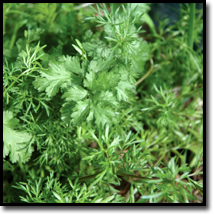
Growing Cilantro
Introduction
| Cilantro (Coriandrum sativum) is an Apiaceae or part of the Umbelliferae family including species like parsley, carrot, dill, fennel and celery. It is also known as Chinese parsley, dhania or kothmir. |  |
Featured in the cuisines of the Middle East, North Africa, Europe and Asia, cilantro has a culinary history dating back millennia. Seeds were found in 8,000-year-old caves in Israel. There are ancient Sanskrit and biblical references to coriander.
Types
There are numerous varieties of cilantro including Leisure, Slo Bolt, Caribe, California Long Standing, Jantar, Santos, Terra, Costa Rica, Lemon, Delfino, and Moroccan.
Jantar and Santos are “bolt-resistant” varieties, which keep plants from flowering due to overly warm temperatures.
Germination & Propagation
Cilantro plants do not handle transplanting well so we recommend that you sow seeds directly into the garden location or pot where they will eventually be growing.
To plant, cover them with about a quarter-inch to a half-inch of soil and water lightly every day. Seeds are best stored in the refrigerator and can be purchased directly from us via our Seed Store. We get our seed stock directly from the College of Tropical Agriculture and Human Resources (C/T/A/H/R), University of Hawaii at Mānoa.
Planting
Set the seeds 2 inches apart in rows 12 to 15 inches apart if you are planning to harvest cilantro leaves. If you plan to harvest the seeds, plant the seeds 8 inches apart in rows 15 inches apart.
Sun and Water
Cilantro grows very well in Hawaii. Four to eight hours of direct sunlight per day is ideal; more hours of sun will produce more leafy material at a quicker rate.
Water the plants on a schedule that provides them with a wet cycle followed by letting the soil dry without causing any wilting or plant stress. That way the roots have access to both water and air so as to bolster vibrant growth.
Fertilizing
Feeding cilantro plants can be somewhat tricky; while they will happily eat what you provide; trying to limit it to just what they need is where you want to be for the optimal flavor profile.
Since cilantro is primarily leafy it eats a lot of nitrogen. The perfect top feed is a Nitrogen rich fertilizer like a dessert bat guano with added blood meal.
Harvesting
Harvesting cilantro leaves should be done often to stave off the bolting process. Do this by pruning the main stem just above the secondary branch (which will now grow to become the primary stem).
The dry fruits are coriander seeds. The word "coriander" in food preparation may refer solely to these seeds (as a spice), rather than to the plant. The seeds have a lemony citrus flavor when crushed, due to terpenes linalool and pinene. It is described as warm, nutty, spicy, and orange-flavored.
If seeking to produce seeds for making ground coriander, allow the plants to bolt and then fully mature before harvesting.








